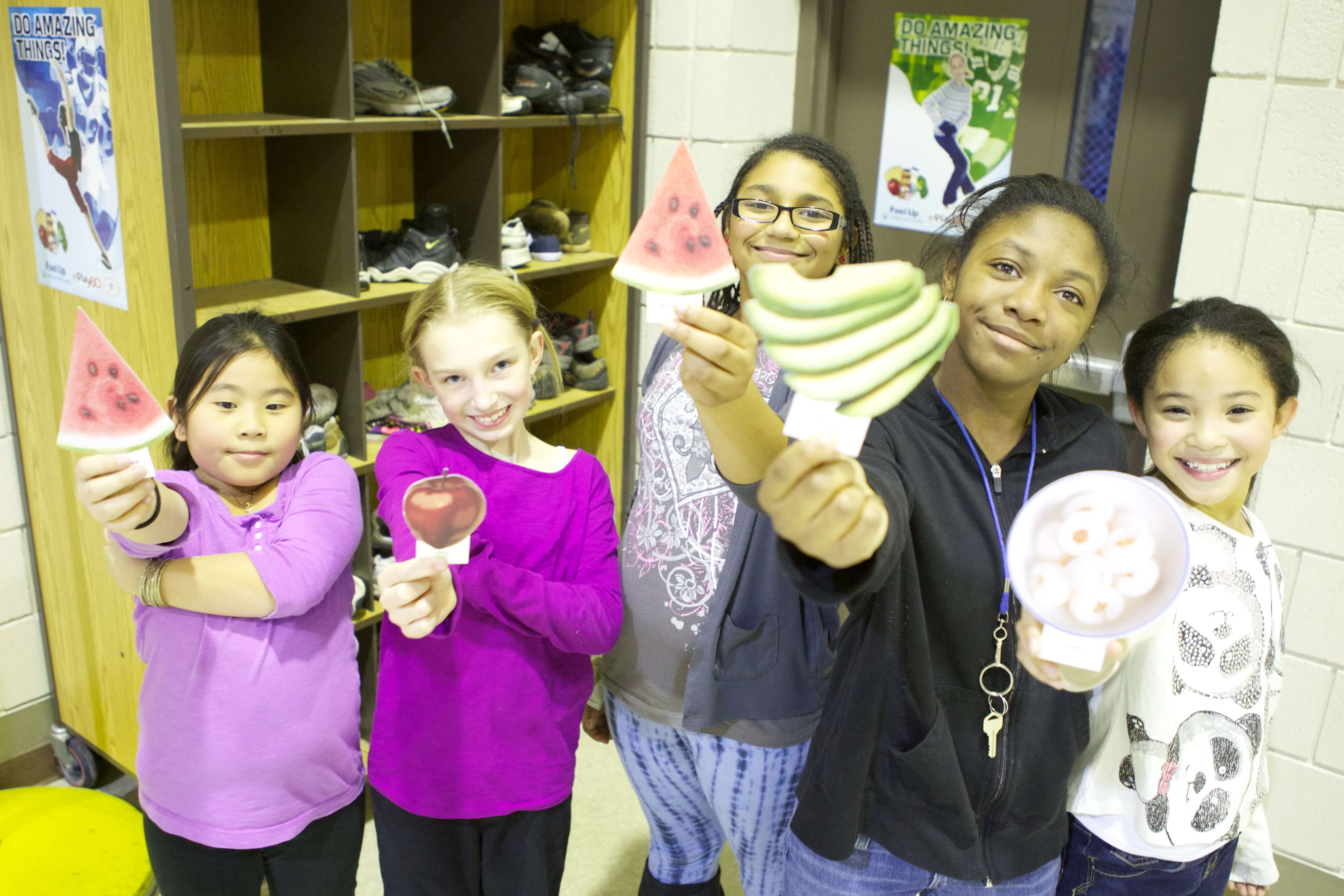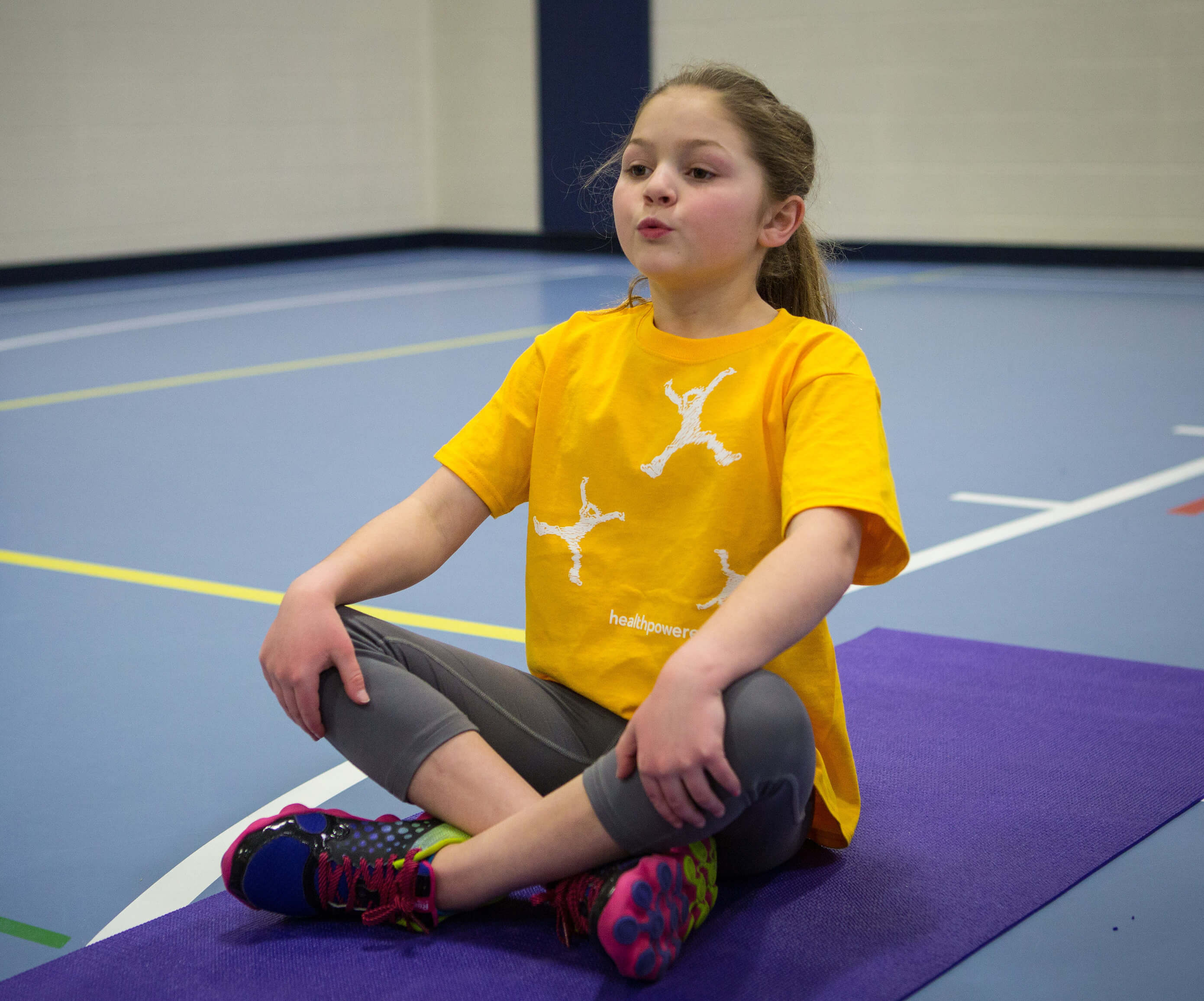

Place the hula hoops into six separate areas of the gym. If hula hoops are not available, choose four corners and two middle areas of the gym. Label each hula hoop or area of the gym with the five food groups, (fruits, vegetables, grains, dairy, protein, plus one hula hoop for unhealthful food (to supplement the ‘Fast Food Alert’ lesson). Scatter the laminated food cards or photos throughout the gym. The goal is for students to run around the gym and sort the foods into the right food group.
For example, a photo of an orange goes in the fruit category. A photo of a steak goes in the meat category.
*For the Fast Food Alert lesson; have one more hula hoop labeled with unhealthful food and laminate fast food/unhealthful food for this hoop.
 Back to Top
Back to Top

Have students stand with their feet shoulder width apart. Instruct them to squat down (as though they are pretending to sit down a chair), being sure to keep their stomach muscles tight and their backs straight to prevent injury. Using their arms for counter-balance, they can reach out. Tell them to slowly squat down until their knees are bent to 90 degrees, and knees do not go past their toes, hold for a count of 3 seconds and slowly stand back up. Do sets of 8-10 repetitions. You could encourage the students to also incorporate doing squats during a TV commercial, or doing a set of 10 here and there throughout the day.
 Back to Top
Back to Top

Have students move so they have room to use the edge of their chair. Have each student grip the edge of chair with legs extended out in front of the chair. The student will then lower their body down toward the ground, (keep back close to the chair edge) while bending at the elbows, lower down until elbows are approximately 90 degrees, then straighten elbows while bringing the body back up to starting position. A good example to explain this activity to students would be to pretend they are scratching their backs (from bottom to top on the way down and top to bottom on the way up) against the edge of the chair, their back however should not actually touch the chair edge, but be very close.
Wheelchair push-ups or use a chair with arms rests and pressing arms straight. Bend knees and use legs to help support.
 Back to Top
Back to Top

Tell the students to think of a name of a fruit and remember it. Then tell the students to move about the gym and find another person who has selected the same fruit as you have. When two students with the same fruits find each other they stop and do five jumping jacks, three push-ups or any other chosen activity. Once the two food items have found each other and the activity is completed, the students should think of a different fruit and start moving to find the new fruit item chosen.
For example: John and Marissa have each selected apple. They move around the room. When they whisper the word “apple” to each other, they find out that they have a match. They both do five jumping jacks and then each pick a new fruit and start looking for that fruit match.
This game could also be played with any other food group category as well as fitness activity (swimming, running, baseball, etc.).
 Back to Top
Back to Top

Choose five corners/walls to be stations. Label each of the five stations as one of the five main food groups (fruits, vegetables, grains, dairy, protein). The teacher will then close his or her eyes and count aloud from 10 down to zero.
As the teacher counts, the students move quickly around the gym or play space to any food group wall/corner of their choice. The students need to select and stop at one of the five stations before the teacher reaches zero.
When the teacher is down to zero, with eyes still closed, he or she will choose a food group, call out that name (such as vegetables) and all students standing at that station will be eliminated. The eliminated students will then go to the center of the gym and the game starts over with the remaining students. The game continues until only a few students remain standing and they are considered the winners of the game or that round.
 Back to Top
Back to Top

Establish a new daily rule every day that includes physical activity. Lunge to the water fountain, tip toe to the pencil sharpener, stretch before sitting down, or hop 5 times when getting out of your seat. Eventually the students can start making the rule.
If you have youth who use a wheelchair, provide them with options of a “daily rule” to bring them into the game!
 Back to Top
Back to Top

When the students line up against the wall to leave the classroom or other designated place, have each student face the wall and perform 10 wall push-ups. After all push-ups are completed the class can walk in line.
Do push-ups from a seated position by using a desk or table.
 Back to Top
Back to Top

For a quick movement break in between lessons have each student place a ruler or a strip of tape on the floor. Jump over the ruler or tape 10 times.
 Back to Top
Back to Top

Before beginning:
Depending on how much time you have, you can take your students just through the mindful breathing and add in the Moon Walk Yoga activity to engage right and left brain thinking.
Optional: Do eight of our Power Charger yoga poses/movements in order:
Take time for each, doing at least five full breaths each. You can also time each pose/movement for one minute. Allow two to five minutes for the Sea Turtle: Deep Relaxation pose at the end.
 Back to Top
Back to Top

Lie on your stomach on the floor. If you are sitting in a chair, sit up straight with your feet flat on the floor.
Put your hands on the floor under your shoulders. If you are sitting in a chair, put your hands on your knees or desk.
Stretch your upper body up high, with your arms straight and your stomach resting on the ground. If you are sitting, lean forward slightly, push your hands against your knees or desk and push your shoulders back to look up slightly, keep your neck as straight and in-line with your spine.
Stretch your head as far up as you can and HISS! Feel the stretch in your spine.
You are a very fierce cobra snake!
Keep stretching and breathing in and out, and make a hissing sound when you breathe out, continue this breathing and hissing for a minute.
If you are on the floor, breathe in and lift your “tail” (feet) up by bending your knees. Try to bring your head and “tail” (feet) close together. Can they touch each other?
 Back to Top
Back to Top